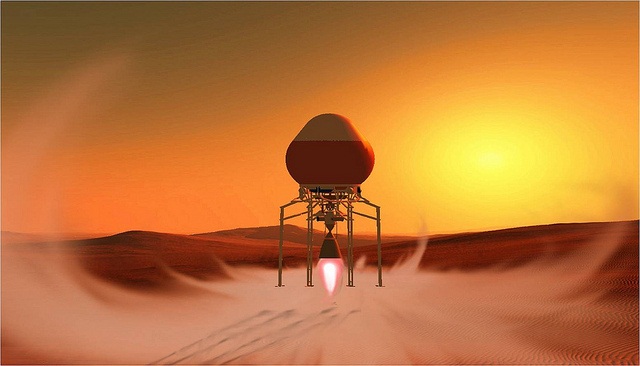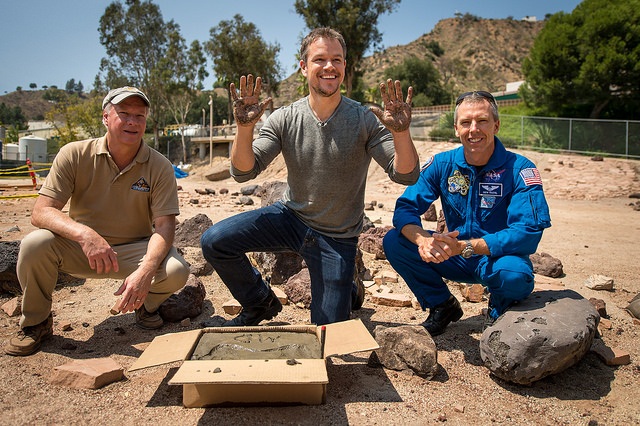Are We Alone?
[youtube]https://www.youtube.com/watch?v=LHMQyQ_YwL8[/youtube]
This hands-on activity is part of the six-unit Manned Mission to Mars lesson and Mission to Mars curricular unit from TeachEngineering.org.
Summary
The year is 2032 and your class has successfully achieved a manned mission to Mars! After several explorations of the Red Planet, one question is still being debated: “Is there life on Mars?” After establishing criteria to help look for signs of life, middle-school student explorers conduct a scientific experiment in which they evaluate three “Martian” soil samples and determine if any contains life.
Grade level: 6-8
Time: 50 minutes
- F. Knowledge gained from other fields of study has a direct effect on the development of technological products and systems. [Grades 6 – 8]
- Construct an argument with evidence that in a particular habitat some organisms can survive well, some survive less well, and some cannot survive at all. [Grade 3]
- Make observations and measurements to identify materials based on their properties. [Grade 5]
- Define the characteristics of a living thing.
- Explain why some living things survive better in certain places than other living things.
- Systematically investigate and analyze soil samples.
- Record observations and conclude if life on Mars exists utilizing the given simulated Martian soil samples.
- Explain why engineers and scientists are interested in being able to find life in soil samples.
Materials List
- 2 Are We Alone? Data Worksheets
- 1 Styrofoam cup
- 3 beakers or baby food jars
- magnifying lens
- 3 soil samples (recipes follow); place one soil sample in each beaker/jar:
- Hot tap water
- Examples of living and non-living items (about 10 items for the class to discuss). Possible examples are: a pencil, a book, a rock, a plant, an apple, a grasshopper or other bug, etc.
Procedure
Before the Activity
- Prepare soil samples for each group:
- The beaker/jar with just sugar, label as “A” (1 tsp., or 5 ml, of sugar mixed with a little less than ¼ cup, or 50 ml, of sand or sandy soil)
- The beaker/jar with sugar and yeast label as “B” (1 tsp., or 5 ml, of sugar and 5 ml of active dry yeast mixed with a little less than ¼ cup, or 50 ml, of sand or sandy soil)
- The beaker/jar with sugar and Alka-Seltzer label as “C” (1 tsp., or 5 ml, of sugar and 1 crushed Alka-Seltzer tablet mixed with a little less than ¼ cup, or 50 ml, of sand or sandy soil)
- Gather multiple items that are living and non-living.
With the Students
- Pass out Are We Alone? Data Worksheets to students.
- Before beginning the activity, have students complete the Criteria For Life table on the first page of the Are We Alone? Data Worksheet. Students should list functions that that they think are key to life in the left column. They should describe each function in the right column.
- Distribute the beakers/jars to each group. Every group should have one sample labeled “A,” one sample labeled “B” and one sample labeled “C.”
- Each research group should formulate a hypothesis regarding their soil sample experiment. Students should write their hypothesis in the space provided (below the Criteria For Life table) on the worksheet.
- Next, have research groups observe soil samples A, B and C. Students may touch and smell the samples. However, ask students not to taste any of the samples. Have groups record their observations in Question 1 of the worksheet.
- Give each group a Styrofoam cup of hot tap water.
- Tell students to slowly and carefully pour the water over soil sample A until the sample is covered with water.
- Repeat step 7 for sample B and C.
- Now, have research groups observe soil samples A, B and C for five minutes after the hot water is added. Have students record any observations in Question 2 of the worksheet.
- Ask students to analyze their data and conclude if any of the Martian soil samples have evidence of life. Remind students that they must provide reasoning for their stated conclusions.
- Have the research groups complete questions 3 and 4 on the worksheet.
- Discuss worksheet questions as a class, after all research groups have completed the worksheet.
Attachments
Safety Issues
Troubleshooting Tips
- Sample A involves physical change of sugar dissolving.
- Sample B (Alka-Seltzer) contains a non-living chemical reaction.
- Sample C (yeast) contains a living chemical reaction. This should be a long term reaction.
Assessment
Pre-Activity Assessment
Activity Embedded Assessment
Post-Activity Assessment
- Topic: Is there life on Mars?
- Name a living thing that grows? (Possible answers: plants, animals)
- Name a living thing that reproduces, replicates or has cell division? (Possible answers: bacteria, single celled organisms, plants, animals)
- Name a living thing with independent movement? (Possible answers: any animal)
- Name a living thing with metabolic processes (respiration, gas or solid material exchange)? (Possible answers: any bacteria, plant, animal)
- Name a living thing with a response to stimuli? (Possible answers: any plant, animal, etc)
Activity Extensions
Activity Scaling
- For 6th grade, have students formulate a hypothesis as a class. If the class is not in agreement, then more than one hypothesis may be formulated. Also, answer questions 4, 5 and 6 from the Are We Alone? Data Worksheet as a class.
- For 7th and 8th grade, conduct activity as is.
InSight Mission to Mars NASA’s Jet Propulsion Lab is launching a probe to explore the Red Planet’s seismology in 2016. The site include resources for students and educators.
JPL engineers and scientists are also excited about the debut of The Martian, based on a book by Andy Weir, and hosted a forum with the author, film star Matt Damon (photo, left), and director Ridley Scott.
The Evolving Search for Life on Mars The New Yorker article, December 15, 2014
References
Activity adapted from NASA’s Searching For Life On Mars and Destination Mars.
Contributors
Daria Kotys-Schwartz, Geoffrey Hill, Chris Yakacki, Malinda Schaefer Zarske, Janet Yowell © 2004 by Regents of the University of Colorado.
Supporting Program
Integrated Teaching and Learning Program, College of Engineering, University of Colorado Boulder
Acknowledgements
Last modified: September 11, 2015
Filed under: Class Activities, Grades 6-8, Grades 6-8, Lesson Plans
Tags: Aerospace, astronaut, Bioscience, Chemistry, Class Activities, exploration, Grades 6-8, Lesson Plan, life, manned mission to Mars, Mars, NASA, Space











